fight club
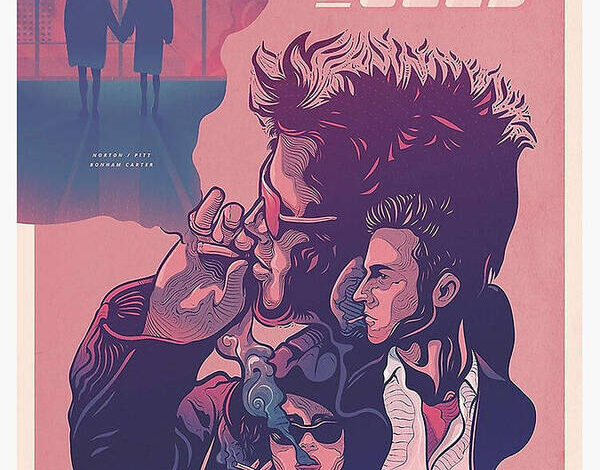
Fight Club: Unveiling the Cult Classic That Changed Cinema Forever
Introduction: A Rebellious Masterpiece
When Fight Club first hit theaters in 1999, few could have predicted its lasting impact on popular culture. Directed by David Fincher and based on Chuck Palahniuk’s novel, this film is far more than just a movie—it’s a cultural phenomenon that continues to challenge and inspire audiences decades after its release.
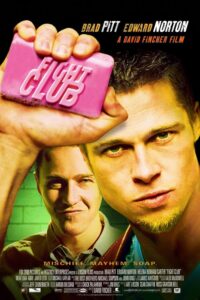
Interesting Fact: Near-Legendary Controversy
Did you know that Fight Club movie was initially a box office disappointment? Despite its current cult status, the film only grossed $101 million worldwide against a $63 million budget. It found its true audience through home video and word-of-mouth, becoming a defining film of its generation.
The Heartbeat of Rebellion: Plot and Characters
The Unnamed Narrator: A Mirror of Modern Discontent
Edward Norton’s character represents the quintessential modern man—trapped in a soul-crushing corporate world, desperately seeking meaning. His apartment, filled with IKEA furniture and empty of genuine connection, becomes a powerful metaphor for contemporary urban isolation.
Fight club Tyler Durden : The Anarchist Within
Brad Pitt’s Tyler Durden is more than just a character—he’s a cultural icon. Representing unbridled freedom and rebellion, Tyler embodies the suppressed desires of men feeling suffocated by societal expectations.
Interesting Fact: Method Behind the Madness
Brad Pitt reportedly lost 20 pounds and worked out intensely to achieve Tyler’s physically intimidating presence. The actor even took soap-making classes to prepare for his role, demonstrating the film’s commitment to authenticity.
Visual Storytelling: Fincher’s Cinematic Genius
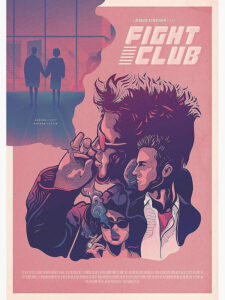
The Cinematographic Approach
David Fincher’s direction transforms Fight Club from a simple narrative into a visual poem of rebellion. His meticulous attention to detail creates a world that feels simultaneously hyper-realistic and dreamlike.
The film’s visual language is a masterpiece of intentional design. Its color palette embraces muted, industrial tones that reflect emotional desolation. The lighting plays with shadowy compositions, creating psychological tension that mirrors the characters’ inner turmoil. Innovative visual effects reveal the narrator’s fractured psyche, blurring the lines between reality and imagination.
Themes That Transcend Time
A Critique of Modern Society
Fight Club emerges as a scathing critique of modern society, dissecting the core issues of consumer culture, modern masculinity, corporate monotony, and the struggle for personal identity. It’s a razor-sharp commentary that cuts deep into the fabric of contemporary existence.
Interesting Fact: Real-World Impact
The film’s critique of consumerism was so potent that some corporations actually used it in marketing training to understand youth disillusionment—ironically missing the point of the film’s message.
The Cultural Ripple Effect
A Film That Speaks to Generations
What started as a controversial film has become a touchstone for generations grappling with profound existential challenges. From identity crises to economic pressure, from suffocating social expectations to the fundamental human desire for personal freedom, Fight Club speaks to the core of human experience.
A Quote from Fight club
“The things you own end up owning you.” – Tyler Durden
This line has become more relevant than ever in our current age of social media and constant consumption.
Behind the Scenes: Casting Magic
Chemistry That Made History
The chemistry between Edward Norton, Brad Pitt, and Helena Bonham Carter isn’t just acting—it’s cinematic alchemy. Each performer brings a unique energy that elevates the film from good to legendary.
Interesting Fact: Casting Revelations
Helena Bonham Carter was initially hesitant about the role of Marla Singer but was convinced after reading the script. Her portrayal became a defining moment in her career.
Why Fight Club Continues to Matter
A Timeless Exploration of Rebellion
Two decades later, Fight Club remains a powerful exploration of masculinity in crisis, the search for an authentic self, and rebellion against systemic conformity. It continues to challenge viewers to look beyond
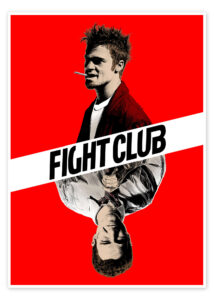
surface-level existence and question the narratives that confine us.
Conclusion: More Than Just a Movie
Fight Club isn’t just a film—it’s a cultural diagnosis, a rebellious manifesto, and a mirror reflecting the deepest anxieties of modern existence.
Call to Action
Whether you’re a first-time viewer or a long-time fan, Fight Club demands your attention. It’s not just a movie—it’s an experience that will challenge everything you thought you knew about yourself and society.
Unveiling the Cult Classic That Changed Cinema Forever
Introduction: A Rebellious Masterpiece
When Fight Club first hit theaters in 1999, few could have predicted its lasting impact on popular culture. Directed by David Fincher and based on Chuck Palahniuk’s novel, this film is far more than just a movie—it’s a
cultural phenomenon that continues to challenge and inspire audiences decades after its release.
Interesting Fact: Near-Legendary Controversy
Did you know that Fight Club was initially a box office disappointment? Despite its current cult status, the film only grossed $101 million worldwide against a $63 million budget. It found its true audience through home video and word-of-mouth, becoming a defining film of its generation.
The Heartbeat of Rebellion: Plot and Characters
The Unnamed Narrator: A Mirror of Modern Discontent
Edward Norton’s character represents the quintessential modern man—trapped in a soul-crushing corporate world, desperately seeking meaning. His apartment, filled with IKEA furniture and empty of genuine connection, becomes a powerful metaphor for contemporary urban isolation.
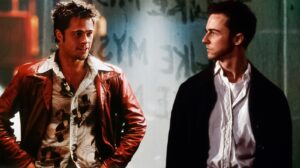
Tyler Durden: The Anarchist Within
Brad Pitt’s Tyler Durden is more than just a character—he’s a cultural icon. Representing unbridled freedom and rebellion, Tyler embodies the suppressed desires of men feeling suffocated by societal expectations.
Interesting Fact: Method Behind the Madness
Brad Pitt reportedly lost 20 pounds and worked out intensely to achieve Tyler’s physically intimidating presence. The actor even took soap-making classes to prepare for his role, demonstrating the film’s commitment to authenticity.
Visual Storytelling: Fincher’s Cinematic Genius
The Cinematographic Approach
David Fincher’s direction transforms Fight Club from a simple narrative into a visual poem of rebellion. His meticulous attention to detail creates a world that feels simultaneously hyper-realistic and dreamlike.
The film’s visual language is a masterpiece of intentional design. Its color palette embraces muted, industrial tones that reflect emotional desolation. The lighting plays with shadowy compositions, creating psychological tension that mirrors the characters’ inner turmoil. Innovative visual effects reveal the narrator’s fractured psyche, blurring the lines between reality and imagination.
Themes That Transcend Time
A Critique of Modern Society
Fight Club emerges as a scathing critique of modern society, dissecting the core issues of consumer culture, modern masculinity, corporate monotony, and the struggle for personal identity. It’s a razor-sharp commentary that cuts deep into the fabric of contemporary existence.
Interesting Fact: Real-World Impact
The film’s critique of consumerism was so potent that some corporations actually used it in marketing training to understand youth disillusionment—ironically missing the point of the film’s message.
The Cultural Ripple Effect
A Film That Speaks to Generations
What started as a controversial film has become a touchstone for generations grappling with profound existential challenges. From identity crises to economic pressure, from suffocating social expectations to the fundamental human desire for personal freedom, Fight Club speaks to the core of human experience.
This line has become more relevant than ever in our current age of social media and constant consumption.
Behind the Scenes: Casting Magic
Chemistry That Made History
The chemistry between Edward Norton, Brad Pitt, and Helena Bonham Carter isn’t just acting—it’s cinematic alchemy. Each performer brings a unique energy that elevates the film from good to legendary.
Interesting Fact: Casting Revelations
Helena Bonham Carter was initially hesitant about the role of Marla Singer but was convinced after reading the script. Her portrayal became a defining moment in her career.
Why Fight Club Continues to Matter
A Timeless Exploration of Rebellion
Two decades later, Fight Club remains a powerful exploration of masculinity in crisis, the search for an authentic self, and rebellion against systemic conformity. It continues to challenge viewers to look beyond surface-level existence and question the narratives that confine us.
Conclusion: More Than Just a Movie
Fight Club isn’t just a film—it’s a cultural diagnosis, a rebellious manifesto, and a mirror reflecting the deepest anxieties of modern existence.
Call to Action
Whether you’re a first-time viewer or a long-time fan, Fight Club demands your attention. It’s not just a movie—it’s an experience that will challenge everything you thought you knew about yourself and society.